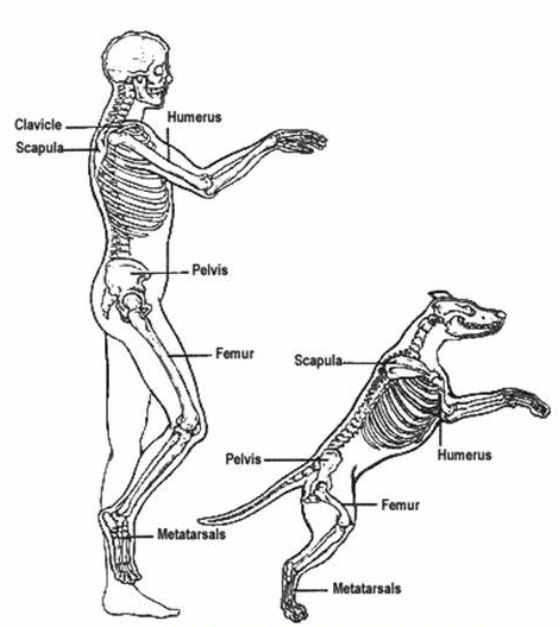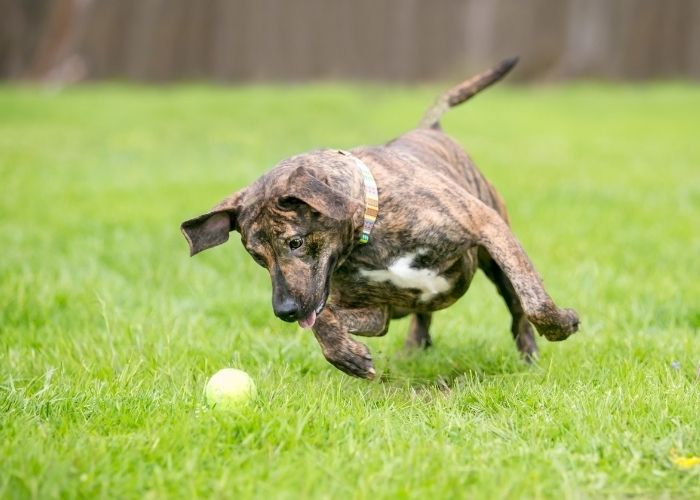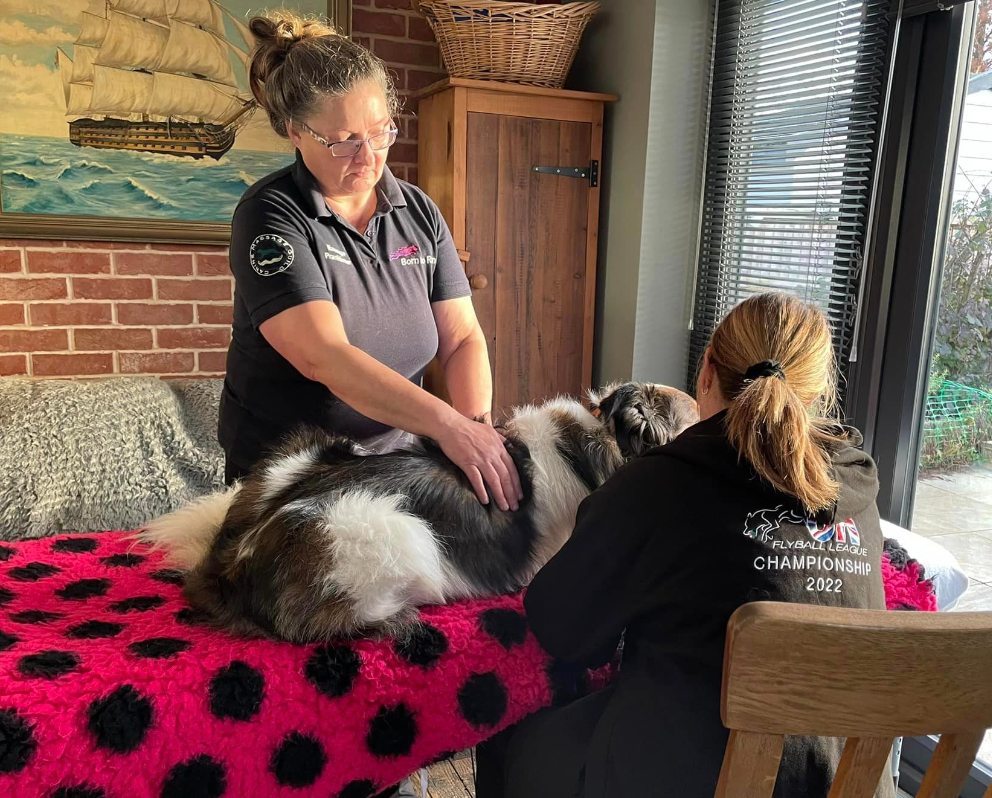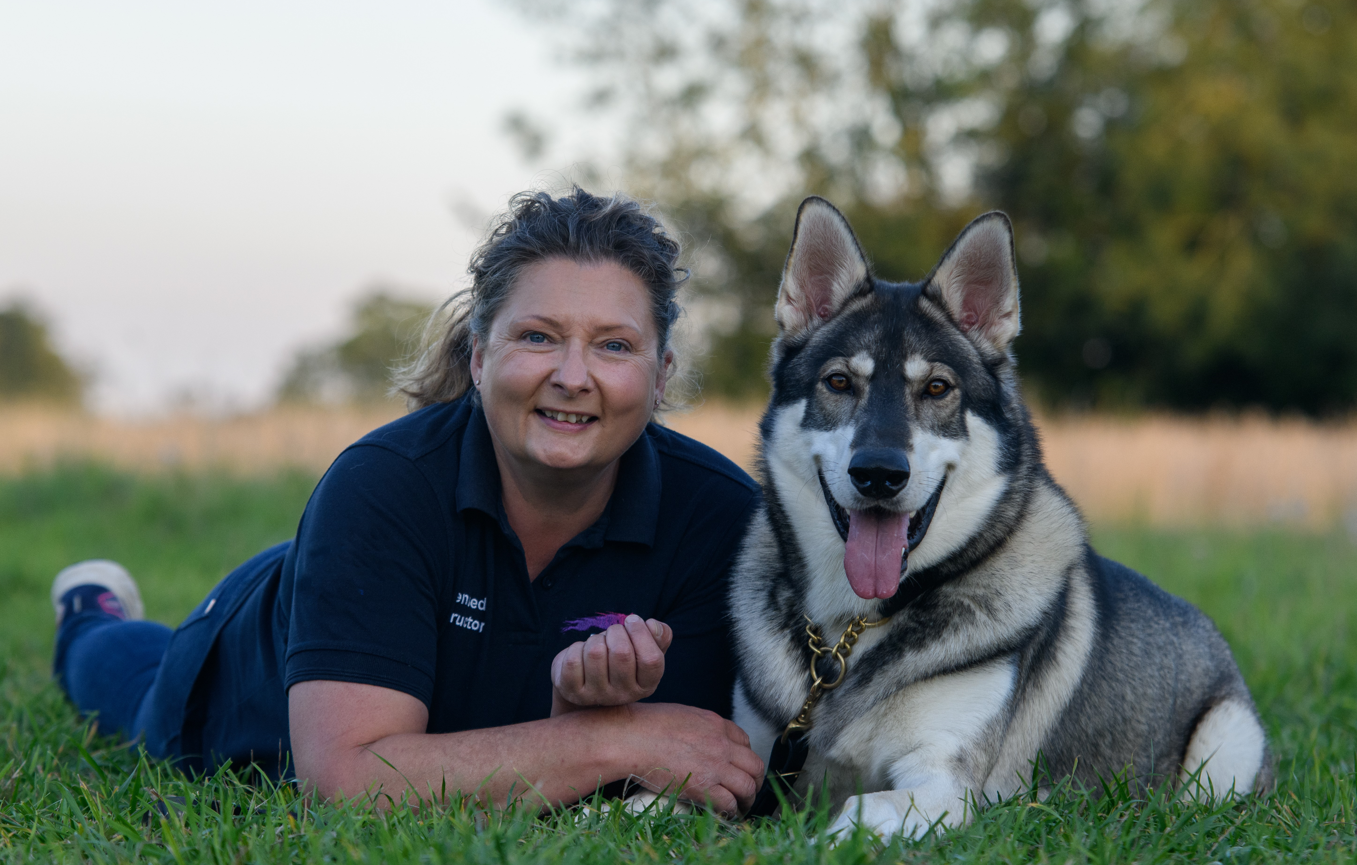You love your dog and want him or her to live their best possible life, right? It’s only natural to want to make sure that your dog feels well. Although, sometimes it’s really difficult to know for sure if they do. But, there are everyday clues to understanding pain in dogs. We just need to know what we’re looking for when observing them go about their daily business.
In this guide, I’ll take you through some of the subtle and most common signs that may mean your dog is experiencing musculoskeletal pain.
Did you know Muscles pull on bones to produce movement?
In order to understand the impacts of pain on your dog’s movement and activity levels, it’s important to appreciate that it’s the muscles that produce movement in the body. Not only that, but we need to also understand just how much of your dog’s body is actually made up of muscle.
How Much Of A Dogs Body Is Muscle?
Well, your dog’s body is an amazing and complex place, where a whopping 45 – 55% is made up of muscle!
There are 700 of these beautiful muscles pulling on 320 bones, to produce movement.
Humans, on the other hand, have a measly 650 muscles and 206 bones.
Sorry humans that’s just how it is!

This step-by-step guide highlights some of the most common and often overlooked, indicators of pain in dogs. But before we look at these let’s first understand what pain is and why it exists.
What is Pain?
Well, the first thing to understand is that pain is very normal and it doesn’t discriminate. Dogs of all ages, breeds, and abilities will experience pain at some point in their lives.
So, in a nutshell, pain is the body’s defence mechanism, a feeling, and even though it’s an unpleasant feeling, it helps to keep your dog safe from harm.
Pain is both powerful and effective because it changes how your dog moves, thinks, and behaves.
So, when the brain genuinely “perceives” the body is at risk of harm, it sends out signals to make the “at risk” area of the body hurt. It then ensures the body takes evasive action, for example taking the weight off an injured leg.
This is outside of conscious control, but is under the control of the central nervous system.
But don’t worry the Nervous System is another topic for another day!

How Long Does Pain Last?
Well of course, that totally depends on the manner of the threat to the body whether a disease, an illness, an emotion, an injury, or trauma. But, what I can tell you is that there are generally two timelines used to describe pain; acute or chronic.
So, what do these terms mean for your dog?
What Is Acute Pain?
Acute pain comes on very suddenly like a “pulled” or strained muscle and could potentially last up to 6 months.
It’s generally expected that acute pain disappears once the injury has healed, or the illness which caused the pain has gone away.
What is Chronic Pain?
Chronic pain usually lasts longer than 6 months.
So, even though an injury may have healed, pain could continue for months or even years. E.g. because osteoarthritis is a degenerative condition, this would cause chronic pain.
Let’s quickly recap what we’ve covered so far;
- Between 45 – 55% of your dogs body is made up of muscle.
- Muscle pulls on bones and it’s muscle that produces movement
- Pain is a normal but powerful survival instinct
- Pain changes how your dog moves, thinks and behaves
- Acute or chronic describes how long your dog’s pain lasts
- The central nervous system controls pain – and phew, we’re not going down that road today!
Pain In Dogs: How Can I Tell If My Dog Is In Pain?
It’s amazing how cleverly our dog’s bodies adapt to cope with any changes in their muscular or skeletal environment. But these adaptations, such as overcompensation, can disguise how your dog really feels.
So, if they hide it so well, how will you know your dog is in pain?
There are some key areas widely recognised in the veterinary world to consider when assessing your dog for pain.
Here are 5 of them. Movement, posture, activities of daily living, character or behavioural changes, and for the working, service, or sport dog this would include the dog’s willingness to perform.
Before we dive into these 5 key areas, please bear the following in mind. Notable changes are changes that are not normal for your dog, whether these are gradual or sudden.
Signs of Pain in Dogs
1. How a dog moves
This is called their gait, and Gait is the dynamic movement of your dog. Gait terminology is a whole language all of its own. Specific terms such as walk, trot, and canter are widely used in the show world, and by vets and musculoskeletal therapists. But it’s just a way of describing the type of movement and the speed at which your dog moves.
These are 5 of the most common movement changes caused by pain.
- Limping or lameness
- Crabbing, pacing, etc,.
- Stiffness on the move
- Hopping or skipping
- Slowing down on a walk
2. Posture
As opposed to gait, these are things you’ll notice when your dog is stood still. This could be in a stand, a down, or a sit. Here are some of the changes things you might see if your dog is experiencing pain.
- Your dog may have an arched back, Which is called roaching or kyphosis, or maybe they have a back that dips in the middle which is called swayback or lordosis. This incidentally is a very common indicator of a weak core.
- You may see coat/fur changes; the coat flicking up or zig zagging unusually in new areas
- Your dog may only lay to one side in a down
- Their back leg/knee may stick out to the side when they sit
- You might see twitching skin down your dogs back
3. Changes In Daily Activities
No one knows their dog better than you, right?
Changes in your dog’s ability to perform daily activities is when you should sit up and take notice!
If your dog does things every day without a problem, you will notice when those things become more difficult, challenging, or just plain painful for your dog. Most people brush it off.
Although you might not feel these things are relevant, they could prove invaluable to your vet or therapist in determining the source of pain. I wonder if you’ve noticed any of these?
Does your dog :
- Appear old before their time
- Groan getting up or lying down
- Drop to the floor with a bump ( This is indicative of a weak core)
- Seem unable to get on the sofa or climb stairs
- Slow down, lag behind or refuse to go on walks
- Have difficulty defecating without moving in circles or your male dog may squat to pee
4. Behavioural Changes
Sudden changes in your dog’s behaviour or demeanor are a huge clue to the presence of pain. Speaking with experienced behaviourists I discovered that up to 80% of “out of character aggression” cases referred to them were found to be pain-related behaviours. I suspect this number could be higher. Here are some of the changes you may see as described by behaviourists and vets:
- Sudden snapping at other dogs or even people
- Not happy to be groomed
- Self-mutilation. Your dog may nibble at their back end, back, wrist or even pull on their tail.
- Lick granuloma. Excessive licking in one particular area until it becomes raw. This then often leads to infection. Which is treated, but the underlying soft tissue issue isn’t resolved.
- As I saw with my elderly husky who was bulletproof until his last year with us, he became noise-sensitive, and anxious. Very often pain in dogs can also manifest in them becoming withdrawn.
5. Unwilling To Work
Dog sports enthusiasts and handlers of working dogs know when there are changes in performance, that something isn’t “right”.
Here are a couple of indicators commonly reported from each sector.
- Agility: Dogs will knock poles, move into the weaves all wrong, or come out of the weaves early. They will measure at jumps or leap over them like they’re 2oft high or 20ft long or take them too wide.
- Running randomly around a competition or training arena in “excitement”???
Sorry, no that’s displacement, anything to avoid the anticipation of discomfort or pain. (I know for many that viewpoint will be a trigger).
In a trained agility dog, your dog is not being naughty it’s the number one way they know how to communicate their discomfort and pain to you.
- Cani-cross/Sled dogs: Early-onset fatigue, reluctance to get into harness, throwing a leg.
- Gundogs: Early-onset fatigue, retrieval issues, reluctance to get in the vehicle.
- Flyball: Turning wide on the box, slower times missing/avoiding hurdles.
- Service Dogs: Reluctance to get in the vehicle, early-onset fatigue, lack of drive poor work ethic.
What Can You Do To Reduce The Risk of Injury and Pain In Your Dog?
Here are 5 quick wins.
1 – Don’t over-exercise your dog
2 – Keep your dog a healthy weight
3 – Cover slippy floors at home!
4 – Throw away the ball launcher
5 – Good Core condition is essential for every dog. this will keep muscles mobile, supple, healthy and strong.

If you think your dog is in pain and you’re worried, what should you do?
Make a note of what you’ve identified as possible pain-related issues and take this information to your vet. It will you save so much time. The quicker the diagnosis the quicker the treatment. For the last 8 years I have recommended to clients that they take photos of their dogs in the sit the stand and the down.
The positioning of your dog in the photos is key: get down to your dog’s level and take images from the front, back, and side. Date them. Park them. When you think there could be a movement or posture issue refer back to your photos and see if there has been a change?
When you pinpoint these changes to your vet or therapist it will speed up the assessment or treatment process.
Are You Worried About Managing Your Dogs Pain Long Term?
Angela may be able to help.
Injury And Soft Tissue Rehabilitation
Born to Run is located in Bury St Edmunds, Suffolk. Working with world championship canine athletes, Angela also supports dogs and their owners with rehabilitation after an injury, diagnosis or operation, when a dog struggles with pain, stiffness or poor mobility
A multi award-winning Small Animal Rehab Specialist and leading CCA Core Conditioning Instructor, Angela, is delighted to have been involved in a world first, contributing to groundbreaking clinical trials that underscore the effectiveness of massage in managing a dog’s pain.
She is also a member if the International Association of Animal Therapists (IAAT) and the Institute of Registered Veterinary Animal Physiotherapists (IRVAP) MT

Using non-invasive treatments, Angela rehabilitates dogs with conditions like osteoarthritis, cruciate ligament injury, hip or elbow dysplasia, IVDD, neurological disorders and undiagnosed lameness etc,.
Angela says “After a diagnosis or operation dog owners are often left not knowing how to help with their dogs recovery at home.
I support them throughout this emotional time using rehabilitation exercise, electrotherapies, kinesiology taping, clinical massage and thermal treatments”
Do you want to work with Angela?
Rehab, exercise, electrotherapies, photobiomodulation, kinesiology taping, clinical massage, thermal therapies PEMF.
Get in touch: angela@borntorun.org.uk
Join the Canine Advocate Facebook Owners Group Advocating for Responsible Dog Ownership and Welfare through education.




I have a 5 1/2 year old cockerpoo who has been experiencing discomfort in her right rear leg/hip since November. She has been checked by the vets who have found nothing wrong and suggested short walks and painkillers. I am a massage therapist and would be interested in using my skills to help my dog. Unfortunately due to my own surgery I am unable to attend next weeks course and would be interested in attending the next one when it becomes available.
Many thanks
Maria Pilgrim
Maria It was really lovely to meet you and Poppy at the Canine Massage Workshop This will help your beautiful girl for years to come x